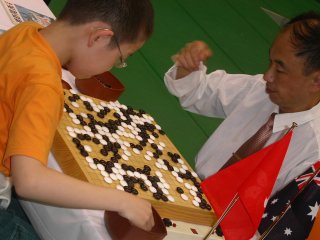 The player from Korea already has passed the pro test and in half a year
will make his official pro debut. He just barely made it to the WAGC and
for a moment there seemed to be the possibility that the organization
would have to disqualify him. It has been decided, however, that this is
not necessary since the Korean participant did have amateur status the
moment he registered for the WAGC. The next point of interest to which
we can expect an answer in a few days: is a fresh Korean pro able to win
the World Amateur's?
The player from Korea already has passed the pro test and in half a year
will make his official pro debut. He just barely made it to the WAGC and
for a moment there seemed to be the possibility that the organization
would have to disqualify him. It has been decided, however, that this is
not necessary since the Korean participant did have amateur status the
moment he registered for the WAGC. The next point of interest to which
we can expect an answer in a few days: is a fresh Korean pro able to win
the World Amateur's?
As many participants already had arrived in Japan Saturday the 20th they
were more than happy to finally start with the first round on Tuesday
the 24th at nine o'clock. After a 30-minute delay due to a printing
error in one of the announcements the participants did the "Nigiri" to
determine black and white. Then finally the Kisei title holder and head
referee officially started the games.
Nigiri, by the way, is only done in the first round. After round one the
computer program, which runs the tournament (three operators) will tell
people what color they have to put up with (this was at least the intention
but due to unforeseen computer trouble the players found themselves doing
nigiri all 8 rounds).
The referee started Romania's representative clock although he had not
yet shown up. He started his game with over 30 minutes less when he did
arrive, unshaven but well showered, a little after ten. His opponent
from Sweden, Martin Li, turned out to be quite a player although he is
not well known.
This was about the same time the first game of the 26th ended the clash
between Uruguay and Canada. None other than the famous James Davies
(live and death, tesuji) had actually tipped Canada's representative as
being a very strong player who might even cause an upset or two. I had
the honor to be the game recorder of the match between Armenia's Ashot
Margaryan and Israel's, Eitan Aharoni.
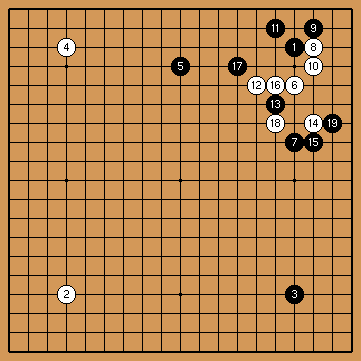
| Event |
26th WAGC, round 1 |
|---|
| Date |
2005 May 24 |
|---|
| Place |
Nagoya, Japan |
|---|
| Black |
Eitan Aharoni, Israel |
|---|
| White |
Ashot Margaryan, Armenia |
|---|
| Commentary |
Hikosaka Naoto, 9p |
|---|
| Game record |
|
|---|
Figure 1: 1-19
There is nothing wrong with the fuseki, of course there are other ways
of going about it but there is no move played by either player which
is questionable or wrong. The first move at which Hikosaka sensei's
expression changed a bit was white 18. The move does not solidify white
much, if black plays like this (dia. 1) he is in trouble.
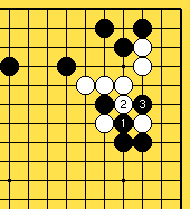
Diagram 1
In Diagram 1 black does not do anything fancy, just capturing one stone
is, however, huge. Black takes profit and the white stones are still
unsettled. White still has to add a few moves which will automatically
mean that black gets more territory.
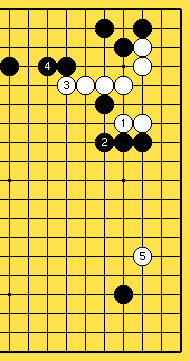
Diagram 2
In Diagram 2 Hikosaka 9p explained that this way of playing is both more
attractive and more solid for white. White 1 makes almost certain life
and white 3 is a counter measure to not get locked up easily. Now white
has created time to play an approach move at 5 and the game is open
again.

Figure 2: 20-39
White 20 is better played directly at 22. Black 25 is not good, directly
capturing at 27 is the move here because?.
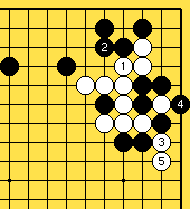
Diagram 3
In diagram 3 it can be seen that if white first plays at 1 and black
answers at 2 the cut at 3 is most severe. After white 5 there are
ways left for black to make eyes at the right and running away with
his two center stones too. This line of play is, however, completely
unattractive for black. If white keeps his cool and doesn't slip
somewhere along the line there is no way he can get a bad result. After
white 5 he has a promising game
White 34 is an overplay. However, it was very interesting to see during
the game that the Armenian player put it there with much confidence and
the representative from Israel reacted quickly with a pure defensive
move. Although it is clear that go is not a game of luck there is more
to it than just putting stones on the board. Reading you opponent's
state of mind and influencing his emotional state by the way you sit
behind the board certainly have to some degree an influence on the
outcome. Playing online does not have this so much but for example speed
of play still can influence the opponent.

Diagram 4
In diagram 4 the variation is shown what happens as black does not buy
the white overplay and moves out immediately with 1. Sacrificing the
lonely white stone will mean an instant big loss, (influence, power,
and later on points), but if white were to run away with 2 black three
attacks both the upper side and the two stones. The game from this point
on would be extremely difficult for white indeed.
In the game white continued to invade the right side, a dangerous
mission. After black 39 white is in trouble. Further moves are omitted
in the end black won by resignation.
This tournament is the second for Eitan Aharoni from Israel and his
third time in Japan. "The first time I came as an official, that
was in 1997 when the world amateur championship was held in the
Sapporo. In 2000 I participated for the first time myself and it was a
great experience, although I did only win 3 games out of 8. For this
tournament I would be extremely satisfied if I could get 5 wins but only
bettering my previous result by one and getting 4 wins too will make me
a happy man"
Aharoni graduated from the University of Tel Aviv where he studied
philosophy and psychology. "Does the knowledge you gained while studying
these difficult subjects actually help you to become a better go
player?" I asked this question expecting to be answered something like
"yes of course, it helps tremendously that I can see in to people's mind
and hearts?" but as it turned out my runaway imagination was not in
sink with reality once again. "No, my studies did not help me with go.
However, there are many aspects of go which touch on my field. I think
that you can tell a great deal about a person by looking at the patterns
which arise in a player's game. I myself can tell that I have difficulty
controlling myself when I feel that I am ahead. It often is the moment
that I start to make the big blunders and I am well aware of this and
try to prevent them from happening.
When the Israeli Go Association got off the ground about 10 years ago
two pro's from Japan also came over for a week to help go enthusiasts
a bit further along the road. It was about that time when I started to
play for the first time. I knew the game through two friends with whom
I played a game every now and then. Half way the nineties I started
teaching at a school for gifted children and although there is not that
much money in it I find it a wonderful and rewarding job.
Good luck to you Mr. Aharoni!
| 

 The player from Korea already has passed the pro test and in half a year
will make his official pro debut. He just barely made it to the WAGC and
for a moment there seemed to be the possibility that the organization
would have to disqualify him. It has been decided, however, that this is
not necessary since the Korean participant did have amateur status the
moment he registered for the WAGC. The next point of interest to which
we can expect an answer in a few days: is a fresh Korean pro able to win
the World Amateur's?
The player from Korea already has passed the pro test and in half a year
will make his official pro debut. He just barely made it to the WAGC and
for a moment there seemed to be the possibility that the organization
would have to disqualify him. It has been decided, however, that this is
not necessary since the Korean participant did have amateur status the
moment he registered for the WAGC. The next point of interest to which
we can expect an answer in a few days: is a fresh Korean pro able to win
the World Amateur's?





